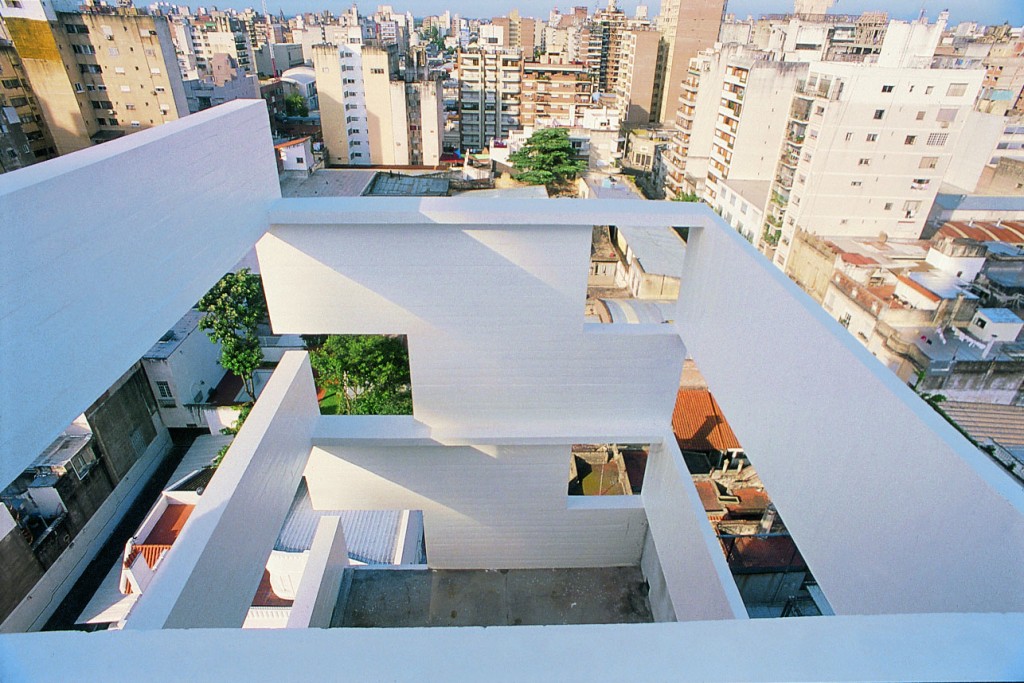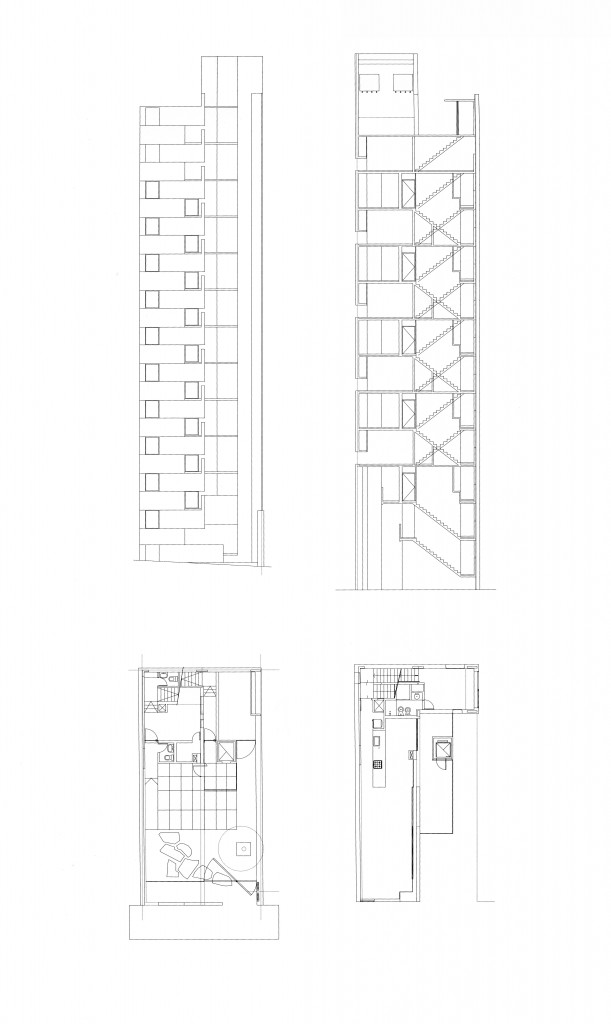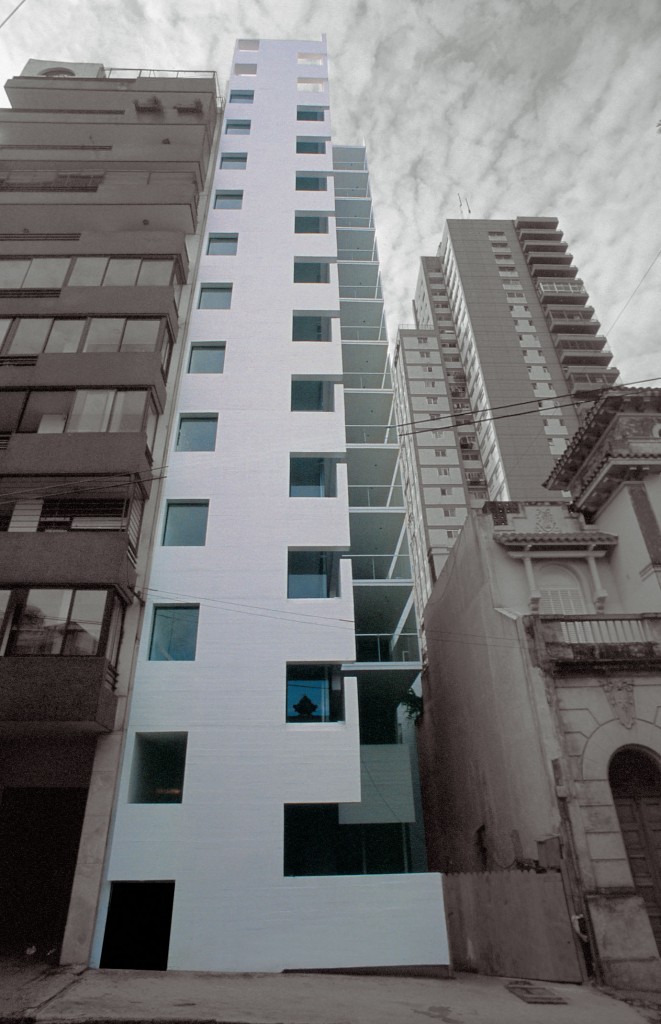critical text by Alejandro Aravena
This is a radical and original building, and it achieves such things within one of the less expected fields: in the real estate market, where the already proven or where old answers, only decorated differently tend to be the case, this building proves that there are always, even with lots of constraints and restrictions (and maybe because of them), some degrees of freedom. To access every apartment through the terrace, through a space that might become an extension of the apartment (living room, another bedroom, hall) or another thing (a studio or a small room for rent), carries to an extreme the notion of free plan: it is not just about a flexible distribution but an openness of the program itself. This building could be the perfect example for Robin Evans’ book, Figures Doors and Passages (which Iglesia does not know by the way) in which is stated that the true invention in architecture has nothing to do with forms or space, but with the nature of human relations (which an architectural plan ultimately describes). Accessing through the terrace is equivalent to the invention of the corridor described by Evans.
On the other hand, this building is a celebration of the gravity force and the absence of horizontal (seismic) loads. As Iglesia himself explains, this building is about neutral pieces, which are not beams, walls, columns, nor windows a priori. Even though they are pieces, they are not like chess ones which have specific functions; it is more like the Japanese GO, where the function of the piece depends of its relative position in the whole. In that way, a piece could be a beam, a wall or a slab, and its absence a window or a door, depending of how and where placed in the system.
The overwhelming aspect of this work is its logic, simultaneously so simple and not so evident. It is exactly this strict logic which transforms the building in an irrational structure, because the neatness of the principle according to which a piece is placed does not requiere to think; one does not need to rationalize, but just act.
****
Si tratta di un edificio radicale e originale, ed è tale in uno degli ambiti più inaspettati: nel mercato immobiliare, dove si tende a preferire ciò che è già stato sperimentato o le vecchie soluzioni, magari cambiandone soltanto la decorazione, questo edificio è la prova che esistono sempre dei margini di libertà, persino quando ci sono molti limiti e restrizioni (e probabilmente proprio a causa di questi). Accedere a ogni singolo appartamento attraverso la terrazza, attraverso uno spazio che potrebbe divenire un’estensione dell’appartamento stesso (soggiorno, un’altra camera da letto, l’ingresso) o un’altra cosa (uno studio o una piccola stanza da affittare) porta all’estremo il concetto della pianta libera: non si tratta solo di una distribuzione flessibile ma di un’apertura dello stesso programma. Questo edifico potrebbe essere l’esemplificazione perfetta del libro di Robin Evans, Figures Doors and Passages (che per inciso, Iglesia non conosce), nel quale si afferma che la vera invenzione in architettura non ha nulla a che fare con le forme o lo spazio bensì con la natura delle relazioni umane (che è ciò che in ultima analisi un progetto architettonico rappresenta). L’accesso tramite il terrazzo equivale all’invenzione del corridoio descritta da Evans.
D’altro canto questo edificio è la celebrazione della forza di gravità e dell’assenza di carichi (sismici) orizzonali. Come lo stesso Iglesia spiega, questo edificio ha a che fare con elementi neutri che non sono travi, muri, colonne né finestre a priori. Sebbene siano elementi, non sono come i pezzi di una scacchiera che hanno funzioni specifiche: è più come il gioco giapponese del GO, dove la funzione dell’elemento dipende dalla sua posizione relativa all’interno del tutto. In questo modo un elemento potrebbe essere una trave, un muro, una lastra e la sua assenza, una finestra o una porta, a secondo di come e dove è collocato nell’ambito del sistema.
L’aspetto dominante di quest’opera è la sua logica al contempo così semplice e non cosi evidente. È esattamente questa rigida logica che trasforma l’edificio in una struttura irrazionale poichè la chiarezza del principio secondo il quale un elemento è collocato non richiede di pensare; non bisogna razionalizzare ma solo agire.
a
a
The text is presented at the exhibition L’architettura che ti piace©/The architecture you like© opened at MAXXI, Rome until 10th April 2011. Info www.fondazionemaxxi.it
Il testo è presentato alla mostra L’architettura che ti piace©/The architecture you like© visitabile al MAXXI di Roma fino al 10 aprile 2011. Info www.fondazionemaxxi.it


